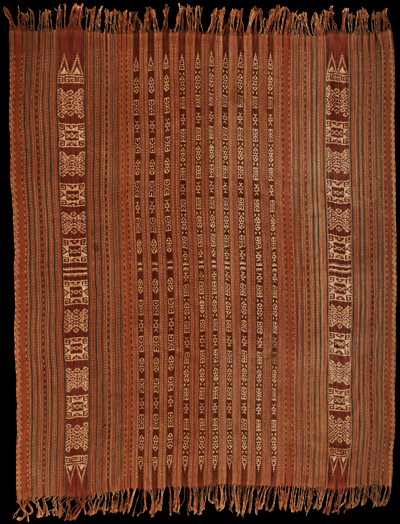| |
 
 | | | |
308 Moluccas, Kisar
Shoulder cloth  
| | Locale: | Probably made my Kisarese mestizos. | | Period: | Early 20th c. | | Yarn: | Cotton, hand-spun, medium, both single and double-ply | | Technique: | Warp ikat | | Panels: | 2 | | Size: | 156 x 189 cm (5' 1" x 6' 2") LW: 1.21 | | Weight: | 1020 g (36.0 oz), 346 g/m2 (1.13 oz/ft2) | | Design: | This is an example of the 'archaic style' as defined in Ikat Textiles of the Indonesian Archipelago, Kisar chapter. Note the boldness of the motifs. One is the characteristic boxed-in eight-pointed star often seen on Kisar (and also on other islands in the wider region). The decoration of the star's central square is very similar to that on the other antique Kisar shawl in our collection, PC 200. The other may represent the double eagle of Maria Theresien Thaler, also a common feature on Kisar cloths, but may equally have been inspired by the patterns of antique Bentenan cloths from northern Sulawesi. The ikat areas were done in doubly ply, very loosely twined, the plain areas in untwined yarn. The warm overall tonality was reinforced by the use of red weft. This, apart from the generous size, is a further indication of the importance that this cloth had for the weaver, as morinda is both harder to get and more difficult to prepare than indigo. | | Comment: | Unusually large cloth - the largest Moluccan shawl we ever encountered. (Note the weight of over 1 kg.) The cloth has the same sienna tonality as PC 200. The dye used was not identified, but is likely to be morinda prepared in a way that in later years was abandoned or modified. The material condition is very good for its age: there is one tiny hole, some fading (more on the side not shown) and light soiling. The overall impression is royal. | | Background: | Chapters on Moluccas and Kisar. | | Published: | Ikat from Timor and its Outer Islands, 2022.
| | Compare: | 200 356 | | Sources: |
A cloth of similar design but far smaller and apparently not asymmetric is held in the Asian Cultures Museum, Acc. nr. 2018-00953. It was previously held in the Nusantara Museum in Delft, the Netherlands, but donated to the ACM when the town of Delft, to its eternal shame, in 2013 decided to stop funding this gem, the world's only museum devoted to Indonesian material culture outside Indonesia. See also Cf. Ten Hoopen, Ikat Textiles of the Indonesian Archipelago PC 200 on p. 499. | | |

©Peter ten Hoopen, 2025
All rights reserved.
|
|


